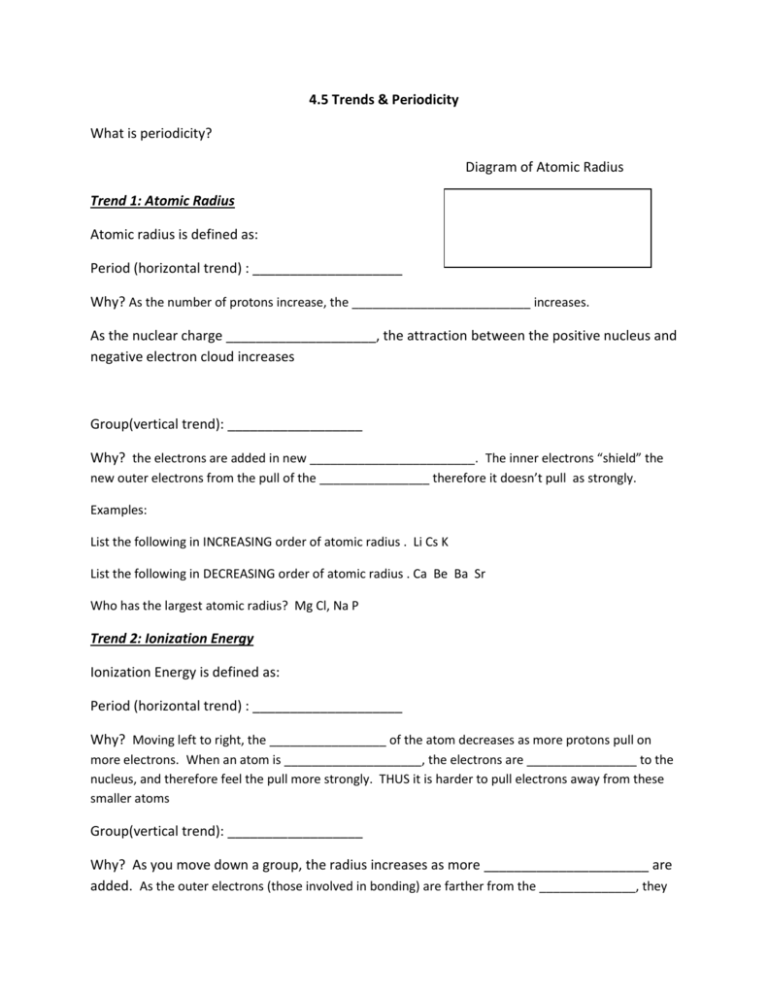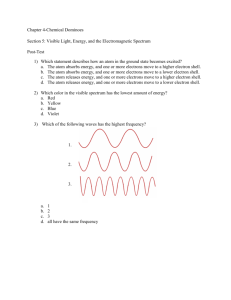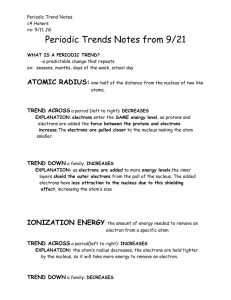lu - sotochem
advertisement

4.5 Trends & Periodicity What is periodicity? Diagram of Atomic Radius Trend 1: Atomic Radius Atomic radius is defined as: Period (horizontal trend) : ____________________ Why? As the number of protons increase, the __________________________ increases. As the nuclear charge ____________________, the attraction between the positive nucleus and negative electron cloud increases Group(vertical trend): __________________ Why? the electrons are added in new ________________________. The inner electrons “shield” the new outer electrons from the pull of the ________________ therefore it doesn’t pull as strongly. Examples: List the following in INCREASING order of atomic radius . Li Cs K List the following in DECREASING order of atomic radius . Ca Be Ba Sr Who has the largest atomic radius? Mg Cl, Na P Trend 2: Ionization Energy Ionization Energy is defined as: Period (horizontal trend) : ____________________ Why? Moving left to right, the _________________ of the atom decreases as more protons pull on more electrons. When an atom is ____________________, the electrons are ________________ to the nucleus, and therefore feel the pull more strongly. THUS it is harder to pull electrons away from these smaller atoms Group(vertical trend): __________________ Why? As you move down a group, the radius increases as more ______________________ are added. As the outer electrons (those involved in bonding) are farther from the ______________, they will feel the “pull” of the nucleus _________________. Thus it is easier to remove an electron from a larger atom. Examples: List the following in INCREASING order of ionization energy . Li Cs K List the following in DECREASING order of ionization energy . Ca Ba Be Sr Who has the highest ionization energy? Cl Na I In Trend 3: Electronegativity Electronegativity is defined as: Period (horizontal trend) : ____________________ Why? When an atom is smaller, the _________________ pulls more strongly. This can attract & draw an electron ________________ from another atom. Group(vertical trend): __________________ Why? The larger atom is less able the nucleus is to ______________________ electrons away from another atom. Examples: Who has the highest electronegativity . Ba Br Ca List the following in decreasing order of electronegativity . I, Cl, Br Trend 4: Ionic Radii & Charge An ion is defined as: Cations are _______________ ions resulting from the ___________ of electrons. Anions are __________________ ions resulting from the __________ of electrons Cations are smaller than neutral atoms! Why? When electrons are lost, there are now more ______________________ than electrons. Therefore, the protons have a _____________________ “pull ” on each of the electrons. Anions are larger than neutral atoms! Why? When electrons are gained, there are now more ____________________ than protons. Therefore, the protons have a _____________________ “pull” on each of the electrons. Period (horizontal trend) : ____________________ Group(vertical trend): __________________ ***** Notice it’s the same trend as atomic radii!**** Examples: Arrange in order of decreasing ionic radius. P-3 Mg+2 Cl-1 Arrange in order of increasing ionic size: K+1 Cs+1 Li+1 Trend 5: Reactivity Reactivity is defined as: For Metals Period (horizontal trend) : ____________________ Group(vertical trend): __________________ Why? The more reactive metals have the ____________________ ionization energy For NonMetals Period (horizontal trend) : ____________________ Group(vertical trend): __________________ Why? The most reactive nonmetals have the ______________________ ionization energy and electronegativity 4.6 Light Electromagnetic radiationis all _____________________ that exhibits wavelike behavior and travels through space. Examples are: ____________________________________________ All energy travels at the speed of light which equals _____________________ Electromagnetic Spectrum (EM spectrum) c Identifies all forms of electromagnetic radiation = Wave Properties ________________________() is the distance from trough to trough of a wave (measured in meters “m”) ________________________ () is the number of times a wave completes a cycle in one second (cycles per second is “Hertz” or “Hz”) Notice that the shorter the wavelength, the __________________ the frequency. This is a __________________ relationship Using the EM SPECTRUM above, notice as frequency increases, the amount of energy _____________________. This is a _____________________ proportional relationship. ________________________ is a small region within the spectrum that has wavelengths/frequencies that are eyes can detect. ROY G BIV is a mnemonic to help you remember the colors of the spectrum. Red is near _________________ and violet is near ultra violet. Examples using Reference Sheet 1. Which of the following forms of electromagnetic radiation has the shortest wavelength? a) gamma b) visible c) infrared d) radio 2. As the frequency of electromagnetic radiation increases, its wavelength ______________. a) increases b) decreases c) remains constant d) is impossible to determine. 3. Which of the following forms of radiation has photons with greatest amount of energy? a) red light b) yellow light c) green light d) violet light 4. What type of electromagnetic radiation is represented by a wavelength of 1870 nm? a) infrared b) visible light c) ultraviolet d) x-ray 5. What type of electromagnetic radiation is represented by a wavelength of 4.7x10-1 m? a) gamma rays b)infrared c)microwaves d) visible light Continuous Spectrum vs. Line Spectrum Continuous Spectrum: Sunlight (or white light) will produces a _______________ of color because there are no _____________ wavelengths. Line Spectrum is when _______________________ atoms emit light of only certain ____________________. Each element has its own line spectrum. How can a line spectrum be explained? Energy packets called _______________ or quanta come in contact with an atom and collide with an electron EXCITATION: this is the process of an electron __________________ a photon of light and being promoted to a higher energy level from its _________________ state The electron cannot remain in the excited state indefinitely SO RELAXATION: the process of an electron ______________________ the photon of light it absorbed and falling back down to a lower energy level. The higher the Energy of a photon, the greater the jump. For example, a photon of __________________ light would have more energy than infared light so there would be a higher jump. See diagram below. The TOTAL ENERGY IN = TOTAL ENERGY OUT If an atom absorbs a large photon of energy that moves it up 2 energy levels, it will release the exact same amount of energy but it can be released in smaller packets moving the electron back down in ______________________ manner. The energy of the photon must ___________________match the energy change of an electron. If it does not match, the energy passes through the electron with no change. Hydrogen Line Spectrum: The colored lines are the wavelengths of light that were emitted when the electron’s moved from a higher to a lower energy level. The blue line is a result of the electron moving from the 4th to the 2nd energy level. Bohr’s study of light gave him the proof that atoms had fixed energy levels. Examples using the Reference Sheet 1. On the energy level diagram below, draw an arrow representing the electron in hydrogen’s ground state being excited to the fourth energy level. 2. An electron in the hydrogen atom makes the transition n = 5 n = 3. a. Determine the wavelength of light associated with this transition. Include units. a) 434 nm b) 434 m c) 1282 nm d) 1282 m b. Classify the type of electromagnetic radiation this wavelength represents: a) infrared b) visible light c) ultraviolet d) x-ray c. Is this energy emitted by the atom or absorbed by the atom? __________________ Flame Tests ___________________ can be identified by the _______________ of light they emit. When metals absorb energy from a flame, the ________________ absorb energy and are raised to higher ______________________. When they return to their____________________, they release the energy they absorbed in the form of ______________________. The wavelength of light of some metals fall in the _____________ light portion of the spectrum. This allows us to see their color.









